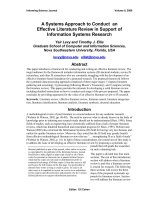Lecture A systems approach to small group interaction (8/e): Chapter 2 - Stewart L. Tubbs
Bạn đang xem bản rút gọn của tài liệu. Xem và tải ngay bản đầy đủ của tài liệu tại đây (765.92 KB, 46 trang )
CCHH AAPP TT EE RR
21
Communication
Processes
Stewart L. Tubbs
McGrawHill
© 2004 The McGrawHill Companies, Inc. All rights reserved.
Slide 2
Communication Processes
•
•
•
•
•
•
•
•
•
McGrawHill
Glossary
Case Study
Communication
Case Study
Language Behavior
Case Study
SelfDisclosure
Interaction Roles
The Systems Approach
© 2004 The McGrawHill Companies, Inc. All rights reserved.
Slide 3
Glossary
• Appropriateness—includes several factors that help
determine the timing and extent of selfdisclosure.
• Bypassing—a misunderstanding that occurs when the
sender . . . and the receiver . . . miss each other with their
meaning.
• Content and Process—content of a group discussion
includes comments about the topic of the discussion.
Process is the manner in which the discussion is conducted.
McGrawHill
© 2004 The McGrawHill Companies, Inc. All rights reserved.
Slide 4
Glossary
• DefensiveSupportive Communication —
defensive communication occurs when a psychological
barrier is created, known as a defense mechanism. This
barrier acts to reduce effective communication. Supportive
communication minimizes these types of problems.
• Emotional Intelligence—personal and interpersonal
skills that enable one to induce desired responses in others.
• GroupBuilding and Maintenance Roles—
help the interpersonal functioning of the group and alter the
way of working by strengthening, regulating, and
perpetuating the group.
McGrawHill
© 2004 The McGrawHill Companies, Inc. All rights reserved.
Slide 5
Glossary
• Group Task Roles—identifiable behaviors that are
•
•
•
McGrawHill
directed toward accomplishing the group’s objective.
Individual Roles—roles that are designed to satisfy an
individual’s needs rather than to contribute to satisfying the
needs of the group.
Inference Making—refers to going beyond
observations and what we know. Inferences have only a
low probability of coming true.
IntentionalUnintentional Communication—
Intentional communication occurs when we communicate
what we mean to. Unintentional communication occurs
when we communicate something different from what we
intend.
© 2004 The McGrawHill Companies, Inc. All rights reserved.
Slide 6
Glossary
• Polarizing—the exaggeration that occurs when people
attempt to make a point.
• Signal Reactions—learned responses to certain
stimuli, such as emotional reactions to offensive swear
words or racial slurs.
• VerbalNonverbal Communication—verbal
communication is the use of words to get across a message.
Nonverbal communication is the use of physical actions,
such as facial expression or tone of voice, to get across a
message.
McGrawHill
© 2004 The McGrawHill Companies, Inc. All rights reserved.
Slide 7
Case Study
The Departmental Email
1. What do you think would have been your reactions if
you were Jones, Cameron, or Hotchkiss?
2. What would have been your reactions if you were one
of the members of the department?
McGrawHill
© 2004 The McGrawHill Companies, Inc. All rights reserved.
Slide 8
Communication
• Emotional Intelligence
– A combination of intrapersonal communication
(personal competence) and interpersonal
communication (social competence).
• Communication Defined
– The process of creating meanings in the minds
of others.
McGrawHill
© 2004 The McGrawHill Companies, Inc. All rights reserved.
Slide 9
Communication
• Communication Defined . . . (continued)
– O’Hair, Friedrich, and Shaver (1998, pp. 45)
identify six key components of effective
communication skills:
1. Creative insight is the ability to ask the right
questions.
2. Sensitivity means [a person] practices the golden
rule.
3. Vision means being able to create the future.
4. Versatility is the capacity for anticipating change.
5. Focus is required to implement the change.
6. Patience allows . . . people to live in the long term.
McGrawHill
© 2004 The McGrawHill Companies, Inc. All rights reserved.
Slide 10
Communication
• Communication Defined . . . (continued)
– Communication among group members may
depend on the nature of the group.
• IntentionalUnintentional Communication
– Unintentional messages may be transmitted by
action as well as by words.
– Like the intended message, feedback also has
content and relationship levels.
McGrawHill
© 2004 The McGrawHill Companies, Inc. All rights reserved.
Slide 11
Communication
• IntentionalUnintentional . . . (continued)
– Groups are one context in which we get
feedback on behaviors that help us eliminate
unintentional cues.
• The gap between what we intend to communicate
and what is actually received is called the arc of
distortion.
• Most experts agree that effective feedback should
(1) be clear and understandable, (2) come from a
trusted person, and (3) be as immediate as possible.
McGrawHill
© 2004 The McGrawHill Companies, Inc. All rights reserved.
Slide 12
Communication
• VerbalNonverbal Communication
– Visual cues
•
•
•
•
•
•
•
McGrawHill
Facial expression
Eye contact
Body positioning
Hand gestures
Style of dress
Physical appearance
Body movements
© 2004 The McGrawHill Companies, Inc. All rights reserved.
Slide 13
Communication
• VerbalNonverbal Communication (cont’d)
– Vocal Cues
• Vocal cues include regional dialects, methods of
pronunciation, and the five major factors:
– Volume—speaking with adequate loudness is the first
responsibility of any communicator.
– Rate and fluency—if the person is able to articulate well, a
faster rate seems to be more interesting to listen to.
– Pitch—refers to the frequency in cycles per second (CPS)
of the vocal tones.
– Quality—refers to the resonance of the voice.
– Inflection—refers to the relative emphasis, pitch changes,
and duration in uttering different word parts in a sentence.
McGrawHill
© 2004 The McGrawHill Companies, Inc. All rights reserved.
Slide 14
Communication
• VerbalNonverbal Communication (cont’d)
– All verbal and nonverbal cues are perceived as a
whole.
– Nonverbal communication takes a different
form at the organizational level.
• An openoffice layout, as opposed to the
conventional, individualoffice design, is often
conducive to communication in the workplace and
can lead to greater employee satisfaction.
• The décor and layout of corporate offices lead to the
impressions that people have about that corporation.
McGrawHill
© 2004 The McGrawHill Companies, Inc. All rights reserved.
Slide 15
Communication
• DefensiveSupportive Communication
– Gibb (1961) described defensive and supportive
communication climates that Whetton and
Cameron (2002) have refined:
Supportive Climates
Description
Problem orientation
Spontaneity
Empathy
Equality
Provisionalism
McGrawHill
Defensive Climates
Evaluation
Control
Strategy
Neutrality
Superiority
Certainty
© 2004 The McGrawHill Companies, Inc. All rights reserved.
Slide 16
Communication
• DefensiveSupportive Communication
– Sometimes it may become necessary to criticize
a group member.
1. Direct critical comments to the work, and not to the
person who performed it.
2. Turn individual criticism into a group criticism by
making the statement general.
3. Present the criticism in a way that forces the group
members to come up with answers to the problem.
McGrawHill
© 2004 The McGrawHill Companies, Inc. All rights reserved.
Slide 17
Communication
• DefensiveSupportive Communication
– LaFasto and Larson (2001) divide
communication patterns into four types:
•
•
•
•
Explicit rejection (disconfirming)
Implicit rejection (disconfirming)
Explicit acceptance (confirming)
Implicit acceptance (confirming)
• Content and Process of Communications
– One rather difficult distinction to make about
group discussion is the difference between the
content of the discussion and the process.
McGrawHill
© 2004 The McGrawHill Companies, Inc. All rights reserved.
Slide 18
Communication
• Listening
– When we can make the other person feel really
understood, we are often seen as effective
communicators.
McGrawHill
© 2004 The McGrawHill Companies, Inc. All rights reserved.
Slide 19
Communication
• Listening . . . (continued)
– Improving listening skills:
1. Pay attention and show positive nonverbal behavior.
2. Listen for content. Describe what you hear, then
attempt to state what it means to you.
3. Try not to interrupt.
4. Try not to argue mentally.
5. Ask for clarification rather than assuming you know
what is meant.
6. Avoid side conversations.
McGrawHill
© 2004 The McGrawHill Companies, Inc. All rights reserved.
Source: Adapted from Gregory, 1999.
Slide 20
Communication—Practical Tips
Tjosvold and Tjsovold (1991) offer the following
practical advice on how to communicate
effectively in a team setting.
1. Express your own ideas clearly and logically, but avoid
arguing blindly for them. Consider other viewpoints.
2. Change your mind based on the … logical [points] of
others. Do not change your mind [only] to avoid
conflict.
3. See a consensus decision. Avoid majority voting,
tossing a coin.
McGrawHill
© 2004 The McGrawHill Companies, Inc. All rights reserved.
Slide 21
Communication—Practical Tips
Tjosvold and Tjsovold (1991) . . . (continued)
4. Foster opposing views. Encourage people to become
involved and speak their minds.
5. Discuss underlying assumptions and ideas.
6. Strive for a winwin solution that incorporates the best
of all ideas.
7. Reconsider an earlier decision. (pp. 13637)
McGrawHill
© 2004 The McGrawHill Companies, Inc. All rights reserved.
Slide 22
Case Study
Niggardly Controversy (A)
1. What do you think of the mayor’s action to dismiss Mr.
Howard for the use of the word niggardly?
2. What do you think of Mr. Howard’s judgment in using
the word in a district that is 65 to 85 percent black?
3. What other examples can you cite of your experiences
in groups where language has created a problem for the
group?
McGrawHill
© 2004 The McGrawHill Companies, Inc. All rights reserved.
Slide 23
Language Behavior
• The study of the interaction between verbal
symbols and the thought patterns associated
with them is referred to as general
semantics.
• Bypassing
– In group discussions, the entire focus of the
discussion may be diverted by a difference in
interpretation of a given word.
McGrawHill
© 2004 The McGrawHill Companies, Inc. All rights reserved.
Slide 24
Language Behavior, Bypassing
—Practical Tips
•
•
•
•
McGrawHill
Be personminded, not wordminded.
Question and paraphrase.
Be receptive to feedback.
Be sensitive to context.
© 2004 The McGrawHill Companies, Inc. All rights reserved.
Slide 25
Language Behavior
• Inference Making
– In attempting to analyze behaviors, it is wise to
recognize that analyses often involve inferences
that go beyond what we have observed and
involve some probability for error.
McGrawHill
© 2004 The McGrawHill Companies, Inc. All rights reserved.









